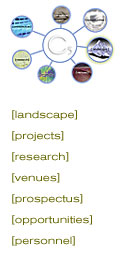 |
Digital Mingling as Postmodern Performance
![]()
Jack Toolin
16 Sessions is a time-relative, collaborative artwork whose outcome, which is largely
arbitrary, is dependent upon the participation of the viewer. It possesses a basic script that,
when followed by the viewer, transforms the viewer into performer. This script, while prescribing
certain actions, allows for a degree of improvisation and arbitrary outcomes based upon the
performer's choices and their persona in the digital world (their current I.P. address). The
fact that 16 Sessions does not completely exist until acted out, that its outcome is to
some degree arbitrary, that it is the result of a complex web of collaboration, and that it exists
in the new theatre of the internet, has led me to consider it as postmodern theater.
At first seemingly far removed from the live, interpersonal world of theatre, one may be reluctant
to see 16 Sessions as performance. However, in some ways it resembles Happenings, the
painting-as-performance works by artists such as Jackson Pollock and Yves Klein, and the
improvisation of Fluxus and Gutai, to name a few. 16 Sessions is not static, it transforms
over time in response to the participation of the viewer. It posseses a narrative structure, though
the character of this narrative is variable.
The collaborative nature of 16 Sessions is complex and polymorphous, overlapping into other
C5 projects and defying the definitive status of the author. A list of its collaborative aspects
follows:
Did I miss anything? This list makes clear the complicated, intertwined nature of 16 Sessions
which I find fascinating. Fascinating because it is the result of many stabs in the dark, or clicks
on the net. And all these layers of participation and evolution have re-contextualized what in
some instances looks like standard modern art (the graphic displays for the sessions, or the
graphic displays for the algorithm results), into a complex postmodern narrative.
But is it a stretch to call 16 Sessions a performance? Doesn't performance suggest a degree
of detachment, that the performer is aware of his/her activity and can therefore manipulate it?
Certainly not all the contributers to the project are, or were, aware of their participation as
performers, though they were aware of their interaction with the project. Could they therefore
control their performance? Maybe, but maybe this level of consciousness is not necessary.
(Afterall, the immersion of a performer into their performance, as in some of Karen Finley's or
Jefferey Byrd's work, is part of what gives that work its passion.) Maybe the viewer is making
decisions intuitively, not unlike an abstract painter. Maybe their performance is somehow more raw,
less pretentious. Maybe.
Okay, so what about an audience? Does a performance require an audience? I would say yes. Does
16 Sessions have an audience? Well, really, the only audience who gets to see the
performance from start to finish is the user - it's an audience of one (possibly two or three).
Does this limitation prevent the project from being considered a performance? Possibly, but I find
it fascinating to think of the visitor to 16 Sessions as one who slips between identities:
first, just a visitor to another web site; second, a performer in the artwork; third, a spectator
of the performance that they performed in.
There is a lot of food for thought in 16 Sessions. Thinking about it as postmodern
performance has revealed these many convolutions regarding collaboration and performance.
There are others to be sure (we only mentioned the issue of authorship, for instance).
Contemplating the project from this perspective has been fun, regardless of 16 Sessions'
status as postmodern theatre, and I hope that my thoughts provoked some interesting thinking of
your own.
![]()
1- The concept of 16 Sessions was developed by C5's staff of twelve during conversations that were
free-form yet guided by previous endeavors.
![]()
2- The concept directly stems from two previous artworks associated with C5: Joel Slayton's
Not to See a Thing (featured in the exhibition, Alternating Currents: American Art in the
Age of Technology at the San Jose Museum of Art [which, incidentally, was co-curated with
the Whitney Museum of American Art]), and C5's Field Mediation on Mingling, performed for the
opening of the San Jose Tech Museum of Innovation. The concept of mingling was applied to the
data generated by Not to See a Thing.
![]()
3- The data from Not to See a Thing was generated by viewers/participants and is represented
in 16 Sessions as 16 graphic displays.
![]()
4- The outcome(s) of 16 Sessions (IP addresses generated by the mingling algorithm) is
the result of the viewer's participation, both in terms of choices they make when selecting
sessions to mingle with, and in their digital persona - their network identity.
![]()
5- Due to the internet's assigning the participant a digital identity, which affects the outcome
of the mingling, it is implicated as collaborator.
![]()
6- Finally, the quality of the outcome or conclusion is dependent upon the web sites served up by
the mingling algorithm. That quality is determined by the sites' creators, hence they are also
implicated as collaborators.